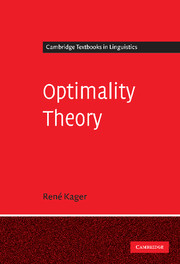Book contents
- Frontmatter
- Contents
- Preface
- 1 Conflicts in grammars
- 2 The typology of structural changes
- 3 Syllable structure and economy
- 4 Metrical structure and parallelism
- 5 Correspondence in reduplication
- 6 Output-to-output correspondence
- 7 Learning OT grammars
- 8 Extensions to syntax
- 9 Residual issues
- References
- Index of languages
- Index of subjects
- Index of constraints
6 - Output-to-output correspondence
Published online by Cambridge University Press: 05 June 2012
- Frontmatter
- Contents
- Preface
- 1 Conflicts in grammars
- 2 The typology of structural changes
- 3 Syllable structure and economy
- 4 Metrical structure and parallelism
- 5 Correspondence in reduplication
- 6 Output-to-output correspondence
- 7 Learning OT grammars
- 8 Extensions to syntax
- 9 Residual issues
- References
- Index of languages
- Index of subjects
- Index of constraints
Summary
Introduction
In this chapter we will consider similarities in the shapes of morphologically related words which are not due to common inputs. We will pursue the idea that such similarities involve the notion of ‘output-to-output correspondence’, the maximization of phonological identity between morphologically related output forms.
A theoretical precursor of OO-correspondence, the notion of ‘paradigm uniformity’, enjoyed a long tradition in pre-generative linguistics (see for example Kuryłowicz 1949). This notion played a modest role in generative phonology (but see Kiparsky 1982a), where similarities between morphologically related forms were attributed to derivational means, in particular the phonological cycle. Recently, paradigm uniformity has been revived in OT by Benua (1995), Flemming (1995), McCarthy (1995a), Burzio (1996), Kenstowicz (1996), Steriade (1996), and others. Disregarding the technical differences between these proposals (referred to as either ‘paradigm uniformity’, ‘uniform exponence’, ‘base-identity’, or ‘OO-correspondence’), we will subsume all under the general notion of OO-correspondence.
OO-correspondence elaborates on the notion of ‘reduplicative identity’, discussed in chapter 5. The reduplicant, part of a surface form, is subject to correspondence constraints requiring identity with its base, which is part of the same surface form. Interactions between reduplicant–base-identity constraints and markedness constraints turned out to be a variation on the major type of constraint interaction in OT: that between faithfulness and markedness.
For example, we discovered a deep similarity between constraints militating against the deletion of input segments, and those enforcing ‘total reduplication’.
- Type
- Chapter
- Information
- Optimality Theory , pp. 257 - 295Publisher: Cambridge University PressPrint publication year: 1999



